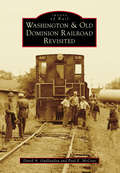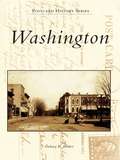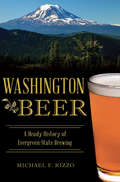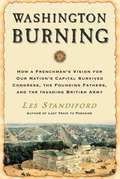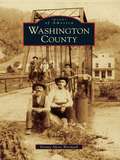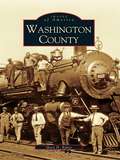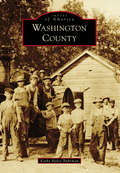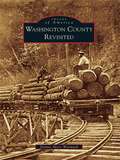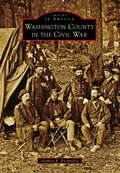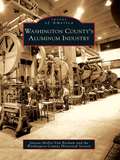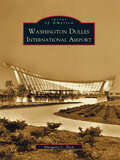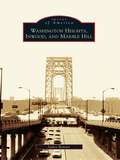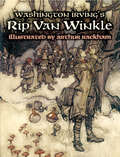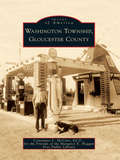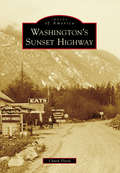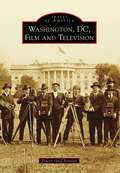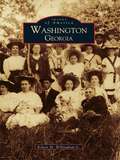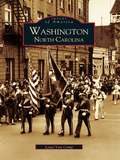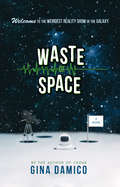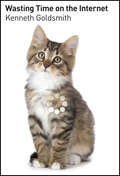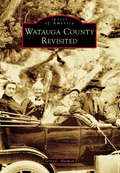- Table View
- List View
Washington & Old Dominion Railroad Revisited (Images of Rail)
by David A. Guillaudeu Paul E. MccrayWashington & Old Dominion Railroad covered therailroad's corporate history, construction, and operation. Thissecond volume expands the coverage with a geographic focus on fourlocations: Rosslyn, Great Falls, Leesburg, and Purcellville. The imageswithin offer a look at the railroad's feed and grain business, railfan-typeviews of equipment, and a visual record of methods used to maintainthe right-of-way and place equipment back on the tracks. Additionally,this work offers a history of the conversion of the right-of-way into thevery popular Washington & Old Dominion Railroad Regional Park.Learn about the history of mills and their place in the local economy.See how the Burro crane was a jack of all trades. Look under the hoodand inside the cab to imagine what it was like to be an engineer onone of the railroad's Baldwin-Westinghouse electric freight locomotives.
Washington (Postcard History Series)
by Zachary R. BordersIn 1825, a blacksmith from North Carolina by the name of William Holland settled in an area east of Peoria. Holland had been employed by the United States government to manufacture rifles for the Native American population in the area, and he later laid out the original town that would be named Washington. This town soon included the proud and beloved commercial square and the beautiful neighborhoods that surround and support it to this day.
Washington Beer: A Heady History of Evergreen State Brewing (American Palate)
by Michael F. RizzoBrewing history touches every corner of Washington. When it was a territory, homesteader operations like Colville Brewery helped establish towns. In 1865, Joseph Meeker planted the state's first hops in Steilacoom. Within a few years, that modest crop became a five-hundred-acre empire, and Washington led the nation in hops production by the turn of the century. Enterprising pioneers like Emil Sick and City Brewery's Catherine Stahl galvanized early Pacific Northwest brewing. In 1982, Bert Grant's Yakima Brewing and Malting Company opened the first brewpub in the country since Prohibition. Soon, Seattle's Independent Ale Brewing Company led a statewide craft tap takeover, and today, nearly three hundred breweries and brewpubs call the Evergreen State home. Author Michael F. Rizzo unveils the epic story of brewing in Washington.
Washington Burning: How A Frenchman's Vision for Our Nation's Capital Survived Congress, the Founding Fathers, and the Invading British Army
by Les StandifordFor the lover of U. S. history or Washingtonian architecture or even basic political intrigue, this marvelous new history, probably the best to date on [Pierre Charles] L'Enfant and his troubled life, is essential. --"Miami Herald. "
Washington County
by Donna Akers WarmuthLocated in southwestern Virginia, Washington County is a land of fertile grounds and rolling hills along the Holston River. Hardy pioneers settled this land in the mid- to late-1700s and tamed the wilderness to establish communities, churches, and schools. Officially formed in 1776, the county was named after Gen. George Washington for his fame and accomplishments before he became president. From the tribes of its original inhabitants to the introduction of the great railways and commerce, Washington County was a major gateway to the West along the Great Wagon Road and saw thousands of settlers and goods pass through on the way to the uncharted lands of the United States. With over 200 images, Washington County provides an intricate visit to the yesteryear of this rural region with scenes of the Virginia Creeper trains and railroads and the larger communities of Damascus, Meadowview, and Glade Spring, as well as early photographs of the smaller communities such as Benhams, Clinchburg, Mendota, and Hayter's Gap.
Washington County
by Mary H. RubinIn the heart of the Cumberland Valley, between the Blue Ridge and Allegheny Mountains, lies Washington County--site of one of the nation's oldest settlements dating back to 1737. Its location betweenPennsylvania and West Virginia places this county at the crossroads of history and commerce. Washington County celebrates the birth and survival of a place and its people over centuries and mirrors the growthof our nation. American history comes alive in this region created independent of Frederick County in 1776, named for Gen. George Washington, and settled by English, French, Swiss, German, and Scottish settlers. Forgotten images of historic mills and bridges will allow readers to journey to the past. Remember the days of the C&O Canal and a way of life that has disappeared forever. Visit historic sites such as Fort Frederick and the first monument to honor George Washington. Relive the heyday of Pen Mar Park and enjoy the waters of Belinda Springs. Feel the effects that the Civil War, the Battle of Antietam, the National Road, and the coming of the railroad all had on this remarkable area years ago.
Washington County (Images of America)
by Kathy Haley BuhrmanThe area that would become Washington County was first settled by the explorers, trappers, and fur traders who traveled by steamboat along the Missouri River to an area inhabited by the Otoe, Missouri, and Omaha Indians. These settlers were pioneers of German, English, Danish, and Irish ancestry who migrated west in search of a better life. They came by steamboat, flatboat ferry, the occasional canoe, on horseback, in wagon teams, and sometimes by foot, venturing into the vast great plains of the frontier. They staked their claims, built sod and hewn-log homes, and traveled on the first post roads using old Indian trails. From the timberland along the river, they pushed westward into the lush rolling hills of red top, timothy, clover, and prairie grasses and tilled the virgin soil to build their futures. It would be another 15 years before the railroad broke ground. These brave men and women journeyed westward, traveling with all their possessions, into the untamed territory that they would later call home.
Washington County Revisited
by Donna Akers WarmuthA companion to Images of America: Washington County, this book, Washington County Revisited, depicts more of the area's rich history. In an attempt to thoroughly cover this county in Virginia, Washington County Revisited explores the history of settlements that were once major community centers, including Lodi, Blackwell's Chapel, Rich Valley, Lindell, Bethel, Taylor's Valley, Hayter's Gap, Clinchburg, and Alvarado. Learn even more of the fascinating history surrounding the railroad towns of Damascus, Glade Spring, and Meadowview. Officially formed in 1776 from Fincastle County, the county was named for Gen. George Washington, who was then serving as commander in chief of the Continental Army. Washington County holds the distinction of being the first geographical region to be named for the first U.S. president. With more than 200 images, WashingtonCounty Revisited provides a unique visit to this rural region that once served as a gateway to the West along the Great Wagon Road and saw thousands of settlers and goods pass through to uncharted lands.
Washington County in the Civil War (Images of America)
by Stephen R. BockmillerWashington County's involvement in the Civil War conjures images of the terrible aftermath of the Battle of Antietam. But many other events occurred there during the war. Wedged into a narrow neck between Pennsylvania and West Virginia, the area was the setting for many important events in the conflict. From John Brown launching his raid on nearby Harpers Ferry at the Kennedy Farm in 1859 to the dragnet that ensnared local citizens following President Lincoln's assassination in 1865, the military was a constant presence. Antietam changed the course of the war and provided President Lincoln the military events needed to issue the Emancipation Proclamation. Harper's Ferry, the C&O Canal, and several rail lines were of vital importance for projecting Union strength into the Shenandoah Valley. They were regularly attacked and defended, and Hagerstown was nearly burned in 1864. Many from across the nation returned home indelibly affected by their experiences in Washington County; some never made it back at all.
Washington County's Aluminum Industry (Images of America)
by Janean Mollet-Van Beckum Washington County Historical SocietyThe aluminum and cookware industries in Washington County were main employers during the 20th century. Manufacturing competitors West Bend Aluminum Company and Kewaskum Aluminum Company (later Regal Ware, Inc.) began production early in the 20th century only eight miles apart. These company histories, while interesting in themselves, would be remiss without discussion of broader influences. Both companies had a substantial effect on American consumerism, women's social roles, and industrial design. Today the West Bend Company and Regal Ware, Inc., are two of the best-known makers of cookware and small appliances around the world. Their ability to survive economic depression, war, and changing times are three reasons for their success and make them excellent examples of the American dream come to life. With deep roots in Washington County, they were able to spread wide nets and capture loyalty around the globe.
Washington Dulles International Airport (Images of Aviation)
by Margaret C. PeckWashington Dulles International Airport is one of the three major airports that transports passengers into and out of the Washington, D.C., metropolitan area. The beauty of the site is admired not only by millions who arrive and leave the area, but by local residents as well. After an extensive study of three separate locations in Virginia, Pres. Dwight D. Eisenhower agreed to the Chantilly site and later chose to rename the world's first jet airport after his former secretary of state, John Foster Dulles. Renowned architect Eero Saarinen designed the magnificent building that serves as a gateway in and out of the United States. Today, the once peaceful farming area and small villages have turned into a fast-paced business world filled with thousands of new homes and residents.
Washington Heights, Inwood, and Marble Hill (Images of America)
by James RennerThe history of Washington Heights, Inwood, and Marble Hill is interesting not only because the communities played a major role in the American Revolution but because of their cultural and educational institutions and residents whose culture and ethnicity have contributed to the well-being of the area. These communities have always been a haven for immigrants who have come here to live and work since the pre-Columbian era. Native Americans came to trade goods, Jewish refugees came during the 1930s to flee the tyranny of the Nazis, and since the end of World War II there has been an influx of the Latino community. The area is also noted for its dolomitic Inwood marble, which has been quarried for government buildings in New York City and some of the federal buildings in Washington, D.C. Through vintage images, Washington Heights, Inwood, and Marble Hill illustrates the transformation of this area over the decades.
Washington Irving's Rip Van Winkle
by Washington Irving Arthur RackhamThese magnificent illustrations, created for a 1905 edition of Washington Irving's enchanting fairy tale, established Arthur Rackham as a leading illustrator of his time. The illustrations featured traits that soon were to characterize much of Rackham's art: flowing pen lines and muted watercolors, forests of looming trees, lovely fairy maidens, and quizzical troll-like figures. Today these images are recognized as among Rackham's very best works.This edition features all 51 full-page color plates, as well as the full text of Irving's classic tale. And enduring foundation of Catskill lore, the captivating narrative recounts the fanciful adventures of an amiable ne'er-do-well colonial farmer who wanders into the highlands, falls asleep after drinking with a band of strange little mountain men, and wakes twenty years later in a world that has passed him by.Effusing a gentle humor, Rackham's art is a constant reminder of a more innocent era. This edition — sure to enchant art lovers — will also delight Rackham devotees and fantasy fans alike.
Washington Township, Gloucester County (Images of America)
by Friends of the Margaret E. Heggan Free Public Library Constance L. McCart Ed.D.Washington Township, now the largest community in Gloucester County, was first incorporated in 1836. Its 22 acres of land, however, had been settled by Europeans as early as the 18th century, when farms were established near Lenni-Lenape encampments. By the mid-19th century, the area listed the communities of Hurffville, Turnersville, Spring Mills or Grenloch Terrace, Dilkesboro, Creesville, Bunker Hill, Chestnut Ridge, and Bells Lake within the township borders. While it remained a farming community throughout the first half of the 20th century, during the 1950s modern housing developments began to replace the farms and peach orchards. The vintage photographs in Washington Township, Gloucester County have been compiled to serve as an archive and assist in preserving the township's rich history.
Washington on Foot, Fifth Edition: 24 Walking Tours and Maps of Washington, DC, Old Town Alexandria, and Takoma Park
by John J. Protopappas Alvin R. McnealThe best way to see--really see--any city is on foot. The perennial favorite Washington on Foot has been compeltely revised and updated to offer 24 walking tours of Washington's neighborhoods. Familiar monuments and museums are all here, side-by-side with lesser-known historic sites and storied residential neighborhoods. Washington on Foot offers history, culture, architecture, urban planning, and much more. It's the complete city in a tidy package and the only "outdoor" Washington guidebook needed. Ideal not only for visitors but for locals who truly want to get to know their city. The updated fifth edition of this essential guide features user-friendly maps, architectural illustrations, historical and culture information, and much more.
Washington on Foot, Sixth Edition Revised and Expanded
by William Bonstra Judith MeanyAn essential walking tour guide to one of the most walkable and historic cities in the US, perfect for first-time visitors and longtime residents alikeThis updated 6th edition of the perennial favorite Washington on Foot features 24 user-friendly maps, including new content on the Wharf, the Smithsonian's National Museum of African American History and Culture, H Street NE, and the Brookland/Catholic University neighborhood. With architectural illustrations and fascinating information on the city's history and culture, Washington on Foot makes touring DC (and its neighboring Old Town Alexandria and Takoma Park) easy, entertaining, and educational. The book guides readers on how to best appreciate all the city has to offer, from familiar monuments and museums to hidden gems and lesser-known historic sites and neighborhoods. Some exciting stops include: The Basilica of the National Shrine of the Immaculate Conception US Botanic Garden Dumbarton Oaks National Gallery of Art Sculpture Garden Friendship Firehouse Mexican Cultural Institute Old Georgetown Incinerator U Street NW There's no better way to experience the history and culture of the nation's capital than to walk through it and catch details you might miss otherwise. Washington on Foot highlights those details, large and small, to make for an unbeatable DC experience.
Washington's Sunset Highway
by Chuck FloodThe Sunset Highway works its way east to west across the 300-mile-wide expanse of Washington State from the Spokane River to its ending at Seattle on Puget Sound. Later known as Highway 10, the route traverses a landscape of big cities, small towns, and wide-open spaces; rolling hills and rugged mountains; fertile fields of grain, apple orchards, and ranches; roaring streams, deep rivers, and rock-walled coulees--now dry, but once a mighty watercourse. The Sunset Highway arose from a collection of existing wagon roads, becoming the main cross-state thoroughfare with highway improvements. As traffic increased, roadside businesses sprang up to accommodate motorists. In towns, bright neon lights attracted both locals and passers-through, while tourist courts, restaurants, burger stands, and service stations lined the highway approaches.
Washington, D.C., Film and Television
by Tracey Gold BennettFor generations, movies and television have been sources of entertainment that have shaped the country's consciousness. Washington, DC, Film and Television chronicles popular and obscure films and television programs that feature Washington, DC. Sharing the sites, neighborhoods, institutions, and monuments that filmmakers used as their settings, this exciting title takes readers behind the scenes of classic movies, including Mr. Smith Goes to Washington, Houseboat, and The Exorcist. Familiar television programs that transmitted local news and information are featured alongside photographs of some of Hollywood's greatest stars. With the nation's capital as a backdrop, the landscape, architecture, and history of Washington have always and will continue to make it an aesthetically exciting and authentic locale for the many story lines of Hollywood.
Washington, Georgia
by Robert M. Willingham Jr.A community once known as the "Golden Buckle of the Cotton Belt," Washington, Georgia, was chartered during the Revolutionary War and was witness to both the birth of two-party politics in Georgia and the last days of the Confederacy. Washington grew up into a sophisticated and cosmopolitan city in the antebellum South, and is today one of the state's most historic places. In this engaging visual retrospective, readers will discover the Washington of days gone by in vintage photographs, many of which have never been published before. From the achievements of prolific leaders such as Robert Toombs and Garnett Andrews to the distinctive architecture of the city's earliest homes and buildings, this volume contains many treasured memories. Both longtime residents of Washington and visitors to the area will delight in this collection of images, culled from the Mary Willis Library, the Washington Historical Museum, and numerous private collections. Coupled with informative captions, the photographs serve as a reminder of the city's past as the community continues to look toward a promising future.
Washington, North Carolina (Images of America)
by Louis Van CampLocated in the heart of Eastern North Carolina, Washington is a city marked by its rich industrial heritage and the surrounding beauty of the Pamlico River and the fertile farmlands of Beaufort County. Washington, the county seat and original namesake of President Washington, grew during the 1800s to become one of the prominent shipping ports for lumber and a variety of agricultural produce. With the arrival of the railroads and the following economic hard times of Depression-era America, Washington's character changed dramatically, forcing many of the local mills and businesses to close. However, today, the city is experiencing a remarkable resurgence of business and opportunity and has again become a significant contributor in the economy of the state. Washington, North Carolina, consisting of over 200 stunning black-and-white photographs and postcards, allows readers a unique opportunity to explore their hometown as never before. As if stepping back in time, readers will experience the Washington of yesteryear, when the masts of commercial ships, like slender church steeples, dominated the waterfront, when the piercing whistles of trains entering and leaving the many lumber mills punctuated the city's daily activities, and when the sounds of horse-drawn wagons and early automobiles echoed throughout Main and Market Streets. This book also captures scenes of daily life: farmers laboring in the field and also meeting at Brooks Store to swap stories, gossip, and advice; people gathered on Main Street enjoying colorful parades; and children swimming at Whichard's Beach Campground and Marina in nearby Chocowinity.
Waste Matters: Adaptive Reuse for Productive Landscapes
by Nikole BouchardFor thousands of years humans have experimented with various methods of waste disposal—from burning and burying to simply packing up and moving in search of an unscathed environment. Habits of disposal are deeply ingrained in our daily lives, so casual and continual that we rarely ever stop to ponder the big-picture effects on social, spatial and ecological orders. Rethinking the ways in which we produce, collect, discard and reuse our waste, whether it’s materials, spaces or places, is essential to ensure a more feasible future. Waste Matters: Adaptive Reuse for Productive Landscapes presents a series of historical and contemporary design ideas that reimagine a range of repurposed materials at diverse scales and in various contexts by exploring methods of hacking, disassembly, reassembly, recycling, adaptive reuse and preservation of the built environment. Waste Matters will inspire designers to sample and rearrange bits of artifacts from the past and present to produce culturally relevant and ecologically sensitive materials, objects, architecture and environments.
Waste and Urban Regeneration: An Urban Ecology of Seoul’s Nanjido Post-landfill Park (Routledge Research in Landscape and Environmental Design)
by Jeong Hye KimWaste and Urban Regeneration examines the Nanjido region of Seoul and its transformation from Nanjido Landfill to the World Cup Park, and its relation to the urban ecology within the context of the city’s urban development during the late twentieth and early twenty-first centuries. The study analyses the urban ecological meanings of the site’s two distinct forms by consolidating them with the Lefebvrian urban theory and relational ecological theories. This book looks at environmental transformations and their link to South Korea’s political and economic changes; how Seoul City controlled waste populations, the borderline characterisations of the inhabited landfill and its community, the regeneration of the landfill into the post-landfill park and site-specific artworks which explored the conflict between the invisible presence of the landfill’s garbage and its history. As one of the first accounts of a landfill and landfill-turned-park of South Korea, this study is a must-read for academics and researchers interested in waste management, ecology, landscape theory and history.
Waste of Space
by Gina Damico<p>Cram ten hormonal teens into a spaceship and blast off: that’s the premise for the ill-conceived reality show Waste of Space. The kids who are cast know everything about drama—and nothing about the fact that the production is fake. Hidden in a desert warehouse, their spaceship replica is equipped with state-of-the-art special effects dreamed up by the scientists partnering with the shady cable network airing the show. <p>And it’s a hit! Millions of viewers are transfixed. But then, suddenly, all communication is severed. Trapped and paranoid, the kids must figure out what to do when this reality show loses its grip on reality.
Wasting Time on the Internet
by Kenneth GoldsmithUsing clear, readable prose, conceptual artist and poet Kenneth Goldsmith’s manifesto shows how our time on the internet is not really wasted but is quite productive and creative as he puts the experience in its proper theoretical and philosophical context.Kenneth Goldsmith wants you to rethink the internet. Many people feel guilty after spending hours watching cat videos or clicking link after link after link. But Goldsmith sees that “wasted” time differently. Unlike old media, the internet demands active engagement—and it’s actually making us more social, more creative, even more productive.When Goldsmith, a renowned conceptual artist and poet, introduced a class at the University of Pennsylvania called “Wasting Time on the Internet”, he nearly broke the internet. The New Yorker, the Atlantic, the Washington Post, Slate, Vice, Time, CNN, the Telegraph, and many more, ran articles expressing their shock, dismay, and, ultimately, their curiosity. Goldsmith’s ideas struck a nerve, because they are brilliantly subversive—and endlessly shareable.In Wasting Time on the Internet, Goldsmith expands upon his provocative insights, contending that our digital lives are remaking human experience. When we’re “wasting time,” we’re actually creating a culture of collaboration. We’re reading and writing more—and quite differently. And we’re turning concepts of authority and authenticity upside-down. The internet puts us in a state between deep focus and subconscious flow, a state that Goldsmith argues is ideal for creativity. Where that creativity takes us will be one of the stories of the twenty-first century.Wide-ranging, counterintuitive, engrossing, unpredictable—like the internet itself—Wasting Time on the Internet is the manifesto you didn’t know you needed.
Watauga County Revisited (Images of America)
by Terry L. HarmonPrior to its formation in 1849, Watauga County was a hunting ground for the Cherokee and part of the trail blazed by frontiersman Daniel Boone, for whom the county seat was later named. Primarily settled by whites after the Revolutionary War, many of the county's earliest families came to the Appalachians from the Piedmont region of North Carolina and, prior to that, from the North--New England, Pennsylvania, Maryland, and Virginia. These settlers were mainly of European extraction--English, German, Scottish, Irish, Swiss, and Welsh--along with a smaller African representation. Nestled in the panoramic Blue Ridge Mountains and unimagined by its early agrarian inhabitants, Watauga would become one of North Carolina's premier tourist destinations and home to Appalachian State University.
